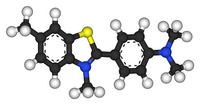Thioflavin

| |

| |
| Names | |
|---|---|
| Preferred IUPAC name
2-[4-(Dimethylamino)phenyl]-3,6-dimethyl-1,3-benzothiazol-3-ium chloride | |
| Identifiers | |
3D model (
JSmol ) |
|
| ChEBI | |
| ChEMBL | |
| ChemSpider | |
ECHA InfoCard
|
100.017.482 |
PubChem CID
|
|
| UNII | |
CompTox Dashboard (EPA)
|
|
| |
| |
| Properties | |
| C17H19ClN2S | |
| Molar mass | 318.86 g/mol |
Except where otherwise noted, data are given for materials in their standard state (at 25 °C [77 °F], 100 kPa).
| |
Thioflavins are
Thioflavin T
Thioflavin T (Basic Yellow 1, Methylene yellow, CI 49005, or ThT) is a
When it binds to
Prior to binding to an amyloid fibril, thioflavin T emits weakly around 427 nm. Quenching effects of the nearby excitation peak at 450 nm is suspected to play a role in minimizing emissions.
When excited at 450 nm, thioflavin T produces a strong fluorescence signal at approximately 482 nm upon binding to amyloids. Thioflavin T molecule consists of a benzylamine and a benzothiazole ring connected through a carbon-carbon bond. These two rings can rotate freely when the molecule is in solution. The free rotation of these rings results in quenching of any excited state generated by photon excitation. However, when thioflavin T binds to amyloid fibrils, the two rotational planes of the two rings become immobilized and therefore, this molecule can maintain its excited state.[1]
Thioflavin T fluorescence is often used as a diagnostic of amyloid structure, but it is not perfectly specific for amyloid. Depending on the particular protein and experimental conditions, thioflavin T may
In adult C. elegans, exposure to thioflavin T results "in a profoundly extended lifespan and slowed aging" at some levels, but decreased lifespan at higher levels.[12]
Thioflavin S
Thioflavin S is a homogenous mixture of compounds that results from the methylation of dehydrothiotoluidine with
